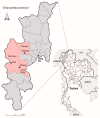Traditional Uses of Leguminosae among the Karen in Thailand
- PMID: 31847100
- PMCID: PMC6963713
- DOI: 10.3390/plants8120600
Traditional Uses of Leguminosae among the Karen in Thailand
Abstract
Leguminosae (legumes) are one of the largest plant families. They are widely used for a variety of purposes by people around the world and include many important cultivated economic food crops. On local scales, legumes are commonly used by various ethnic groups. However, the data are incomplete and scattered, not least in Thailand. We found that species of legumes were important in Karen communities, so we decided to investigate in detail the traditional knowledge of legumes on a local scale among Karen people in northern Thailand. We interviewed six herbalists and eighty-four nonherbalist informants in three Karen villages in Chiang Mai province about their use of legumes, and about the local names for the species, using semistructured interviews. A total of 83 legumes species (in 45 genera) had 4443 use reports. Five of the 83 legume species had not been reported previously as used in Thailand. Most Karen use reports (43%) of legumes were for food, medicine (36%), and materials (8%), but in term of species more legumes (68 species) were used for medicine than for food (53 species). The legume genera with most used species were Crotalaria and Flemingia each with six species. The most important species are Tamarindus indica (CI = 3.38), Senegalia rugata (CI = 2.39), Glycine max (CI = 1.27) respectively.
Keywords: Skaw Karen; cultural importance index; ethnic groups; ethnobotany; fabaceae; fidelity level; legumes; local scale; plant usage; traditional knowledge.
Conflict of interest statement
The authors declare no conflict of interest.
Figures



Similar articles
-
Karen and Lawa medicinal plant use: uniformity or ethnic divergence?J Ethnopharmacol. 2014;151(1):517-27. doi: 10.1016/j.jep.2013.11.009. Epub 2013 Nov 15. J Ethnopharmacol. 2014. PMID: 24247077
-
Traditional knowledge on medicinal plant of the Karen in northern Thailand: a comparative study.J Ethnopharmacol. 2013 Oct 28;150(1):232-43. doi: 10.1016/j.jep.2013.08.037. Epub 2013 Aug 30. J Ethnopharmacol. 2013. PMID: 23999245
-
Ethnomedicinal Plant Knowledge of the Karen in Thailand.Plants (Basel). 2020 Jun 29;9(7):813. doi: 10.3390/plants9070813. Plants (Basel). 2020. PMID: 32610436 Free PMC article.
-
[Legume cross-reactivity].Allergol Immunopathol (Madr). 2003 May-Jun;31(3):151-61. Allergol Immunopathol (Madr). 2003. PMID: 12783766 Review. Spanish.
-
Landmark research in legumes.Genome. 2007 Jun;50(6):525-37. doi: 10.1139/g07-037. Genome. 2007. PMID: 17632574 Review.
Cited by
-
Ethnomedicinal Knowledge of Traditional Healers in Roi Et, Thailand.Plants (Basel). 2020 Sep 10;9(9):1177. doi: 10.3390/plants9091177. Plants (Basel). 2020. PMID: 32927919 Free PMC article.
-
Medicinal Plants for Treating Musculoskeletal Disorders among Karen in Thailand.Plants (Basel). 2020 Jun 28;9(7):811. doi: 10.3390/plants9070811. Plants (Basel). 2020. PMID: 32605228 Free PMC article.
-
A Review of Recent Studies on the Antioxidant and Anti-Infectious Properties of Senna Plants.Oxid Med Cell Longev. 2022 Feb 4;2022:6025900. doi: 10.1155/2022/6025900. eCollection 2022. Oxid Med Cell Longev. 2022. PMID: 35154569 Free PMC article. Review.
-
Phytochemical Profile and Microbiological Activity of Some Plants Belonging to the Fabaceae Family.Antibiotics (Basel). 2021 Jun 1;10(6):662. doi: 10.3390/antibiotics10060662. Antibiotics (Basel). 2021. PMID: 34205938 Free PMC article.
-
Characterization of Bioactive Phenolics and Antioxidant Capacity of Edible Bean Extracts of 50 Fabaceae Populations Grown in Thailand.Foods. 2021 Dec 16;10(12):3118. doi: 10.3390/foods10123118. Foods. 2021. PMID: 34945669 Free PMC article.
References
-
- Lewis G.P., Schrire B., Mackinder B., Lock M. Legumes of the World. Royal Botanic Gardens Kew; London, UK: 2005.
-
- Schrire B., Lavin M., Lewis G. International Symposium, Plant Diversity and Complexity Patterns: Local, Regional and Global Dimensions. Det Kongelige Danske videnskabernes selskab; Copenhagen, Denmark: 2005. Global distribution patterns of the leguminosae: Insights from recent phylogenies. Biologiske skrifter; pp. 375–422.
-
- Larsen K., Larsen S.S., Vidal J.E. Leguminosae-Caesalpinioideae. In: Smitinand T., Larsen K., editors. Flora of Thailand. Volume 4. TISTR Press; Bangkok, Thailand: 1984. pp. 1–129. Part 1.
-
- Nielsen I.C. Leguminosae-Mimosoideae. In: Smitinand T., Larsen K., editors. Flora of Thailand. Volume 4. TISTR Press; Bangkok, Thailand: 1984. pp. 131–222. Part 2.
-
- Niyomdham C. Key to the genera of Thai Papilionaceae plants. Thai F Bull (Bot.) 1994;22:26–88.
LinkOut - more resources
Full Text Sources

